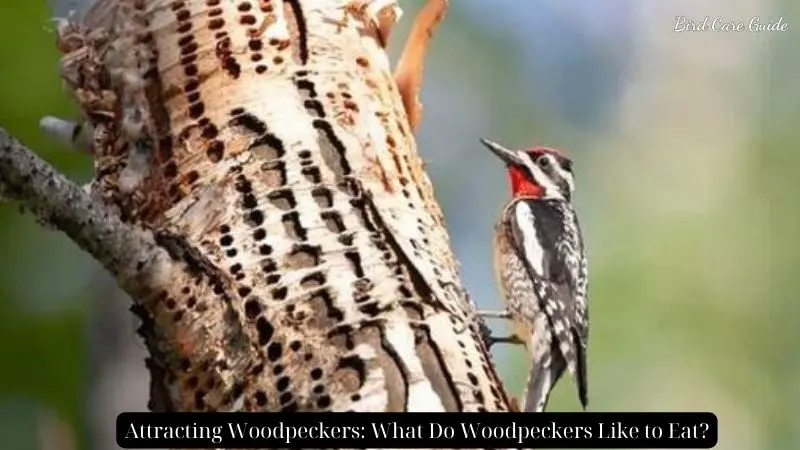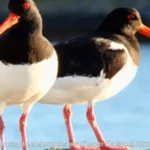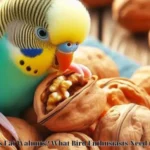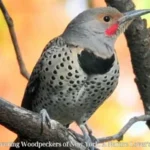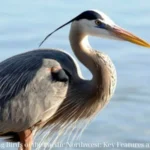Woodpeckers are fascinating birds known for their unique behaviors, including their characteristic drumming on trees. Attracting these birds to your backyard can be a rewarding experience, providing hours of entertainment and the opportunity to observe their intriguing habits up close. One of the key elements to attracting woodpeckers is understanding their dietary preferences. So, what do woodpeckers like to eat?
Let’s “Bird Care Guide” to explore their diet in detail and discover how you can create an attractive environment for these beautiful birds.
Understanding Woodpeckers
Before discussing their diet, it’s important to understand a bit about woodpeckers. These birds belong to the family Picidae, which includes about 240 species worldwide. Woodpeckers are easily recognizable by their strong bills, which they use to drill into wood in search of food and to create nesting sites. They also have stiff tail feathers that provide support as they climb tree trunks.
Woodpeckers play a crucial role in the ecosystem by controlling insect populations and creating nesting cavities used by other birds and animals. They are found in various habitats, including forests, woodlands, and urban areas, making them versatile and adaptable birds.
What Do Woodpeckers Like to Eat?
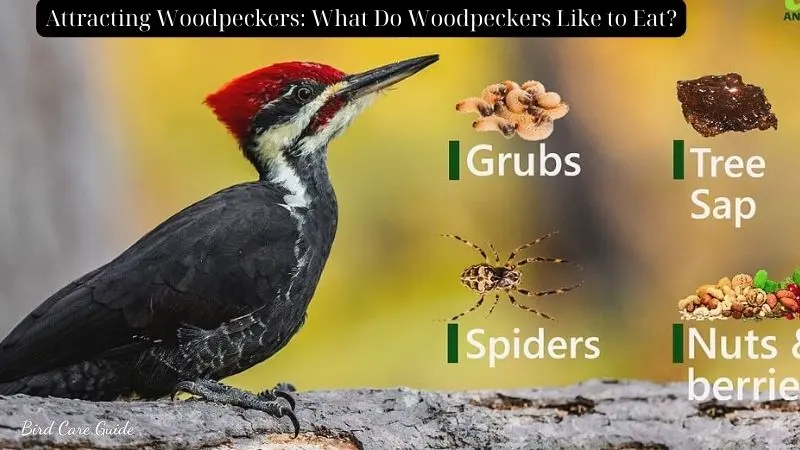
Woodpeckers have a diverse diet that includes insects, fruits, nuts, and sap. Understanding what woodpeckers like to eat can help you provide the right food sources to attract them to your yard.
1. Insects and Larvae
Insects form a significant portion of a woodpecker’s diet. They are particularly fond of beetles, ants, and caterpillars, which they extract from tree bark and wood using their strong beaks. Larvae, or insect larvae, are especially favored due to their high protein content. Woodpeckers use their keen sense of hearing to detect the movement of larvae within the wood.
2. Nuts and Seeds
Nuts and seeds are another essential component of a woodpecker’s diet. Species like the Red-headed Woodpecker and the Acorn Woodpecker are known for their habit of storing acorns and other nuts. Commonly consumed nuts include acorns, pine nuts, and sunflower seeds. These provide essential fats and proteins, especially during colder months when insects are less abundant.
3. Fruit and Berries
Fruits and berries are enjoyed by many woodpecker species, providing a vital source of vitamins and sugars. Commonly favored fruits include apples, oranges, and berries such as blackberries, blueberries, and elderberries. These are particularly important in the late summer and fall when they are readily available.
4. Sap
Some woodpeckers, like the Yellow-bellied Sapsucker, are known for their unique feeding habits, which include tapping into tree bark to consume sap. This sugary liquid provides a quick energy boost and is often shared with other animals that feed on the sap wells created by woodpeckers.
Attracting Woodpeckers to Your Yard
To attract woodpeckers to your yard, it’s essential to provide a variety of foods that mimic their natural diet. Here are some effective ways to attract woodpeckers:
1. Suet Feeders
Suet is a high-energy food made from animal fat. Woodpeckers are particularly fond of suet, especially during winter when insects are scarce. Place suet feeders in your yard, preferably near trees or shrubs where woodpeckers can perch safely.
2. Insect Feeders
Offer live or dried insects such as mealworms, crickets, or ants. You can use specialized feeders or sprinkle insects on tree trunks or near bird baths. This method attracts woodpeckers by providing a natural, protein-rich food source.
3. Fruit and Berry Plants
Plant native trees and shrubs that produce berries and fruits favored by woodpeckers. Examples include dogwoods, elderberries, and serviceberries. These plants not only provide food but also offer natural shelter and nesting sites.
4. Sap Wells
Create artificial sap wells by drilling small holes in trees. Fill these holes with a mixture of water and sugar to mimic tree sap. This attracts sapsuckers and other woodpeckers that feed on sap and the insects it attracts.
5. Nesting Sites
Woodpeckers nest in cavities they excavate in tree trunks. To attract them for nesting, consider installing nest boxes designed for woodpeckers. Place these boxes in quiet, wooded areas of your yard at least 10-20 feet above ground.
6. Water Sources
Provide a shallow bird bath or a small pond with clean, fresh water. Woodpeckers, like other birds, need water for drinking and bathing. Ensure the water source is regularly cleaned and refilled, especially during hot weather.
Creating a Woodpecker-Friendly Environment
To attract woodpeckers to your backyard, it’s important to create an environment that mimics their natural habitat and provides the foods they love. Here are some tips to help you get started.
Provide Suet
Suet is a high-energy food that woodpeckers find irresistible. You can purchase suet cakes from bird supply stores or make your own using beef fat or lard mixed with seeds, nuts, and dried fruit. Place the suet in a specialized suet feeder or a mesh bag and hang it from a tree or bird feeder pole. During the winter months, when natural food sources are limited, suet can be particularly effective in attracting woodpeckers.
Offer Nuts and Seeds
Supplementing the natural food sources in your yard with a variety of nuts and seeds can help attract woodpeckers. Some popular options include sunflower seeds, peanuts, and cracked corn. Use a feeder designed to accommodate these foods, such as a peanut feeder or a platform feeder with a mesh bottom to prevent mold growth.
Plant Fruit-Bearing Trees and Shrubs
Incorporating fruit-bearing trees and shrubs into your landscape can provide a reliable food source for woodpeckers. Consider planting species such as serviceberry, dogwood, and holly, which produce berries that are attractive to woodpeckers. Additionally, fruit trees like apple and cherry can offer both food and potential nesting sites.
Preserve Dead Trees and Snags
Dead trees and snags (standing dead trees) are vital components of a woodpecker-friendly habitat. These structures provide nesting sites, shelter, and a rich source of insects. If it’s safe to do so, consider leaving dead trees or large branches in your yard to attract woodpeckers. You can also create a snag by cutting a tree trunk to a height of 10-20 feet and allowing it to decay naturally.
Offer a Water Source
Providing a clean, reliable source of water is essential for attracting woodpeckers and other birds. A birdbath or a shallow dish filled with fresh water can serve this purpose. Be sure to clean and refill the water regularly to prevent the spread of disease and ensure that it remains appealing to birds.
Understanding Woodpecker Behavior
To successfully attract woodpeckers, it’s helpful to understand some of their key behaviors and how they relate to their feeding habits.
Drumming
One of the most distinctive behaviors of woodpeckers is drumming. This involves rapid pecking on resonant surfaces such as tree trunks, branches, or even man-made structures like metal gutters. Drumming serves several purposes: it establishes territory, communicates with potential mates, and searches for insects. Providing dead trees or installing a drumming post can encourage woodpeckers to visit your yard.
Excavating Cavities
Woodpeckers are cavity nesters, meaning they create holes in trees to use as nesting sites. These cavities are often excavated in dead or decaying trees, where the wood is softer and easier to remove. By preserving dead trees and snags, you can provide potential nesting sites for woodpeckers and increase the likelihood of attracting them to your yard.
Storing Food
Many woodpecker species exhibit food-storing behavior, known as caching. They will hide nuts, seeds, and insects in crevices or under bark to consume later. Providing a consistent supply of these foods can encourage woodpeckers to cache food in your yard, making it a regular stop on their foraging routes.
Common Woodpecker Species and Their Diets
Different woodpecker species have varying dietary preferences. Here are some of the most common woodpecker species you might encounter and their preferred foods.
Downy Woodpecker
The Downy Woodpecker is the smallest woodpecker in North America and is known for its black and white plumage. It feeds on insects, particularly beetles and ants, as well as seeds, suet, and fruit. Offering suet and sunflower seeds is an effective way to attract Downy Woodpeckers to your yard.
Hairy Woodpecker
The Hairy Woodpecker is similar in appearance to the Downy Woodpecker but is larger in size. Its diet consists mainly of insects, including beetles and caterpillars, as well as nuts and seeds. Providing suet and a variety of nuts can help attract Hairy Woodpeckers.
Northern Flicker
The Northern Flicker is a large woodpecker with a distinctive spotted plumage. Unlike other woodpeckers, Northern Flickers often forage on the ground, feeding on ants and beetles. They also consume fruits, seeds, and suet. Planting fruit-bearing shrubs and offering suet can attract Northern Flickers to your yard.
Pileated Woodpecker
The Pileated Woodpecker is the largest woodpecker in North America, easily recognizable by its striking red crest. Its diet includes carpenter ants, beetles, fruits, and nuts. To attract Pileated Woodpeckers, provide suet, nuts, and maintain dead trees or snags for nesting and foraging.
Red-bellied Woodpecker
The Red-bellied Woodpecker has a distinctive red cap and a pale belly. It feeds on insects, fruits, nuts, and seeds. Offering a variety of nuts and suet can help attract Red-bellied Woodpeckers to your yard.
Yellow-bellied Sapsucker
The Yellow-bellied Sapsucker is known for its affinity for tree sap. It creates small holes in trees to access sap and also consumes insects and fruit. To attract Yellow-bellied Sapsuckers, plant fruit-bearing trees and provide suet.
Conclusion
Attracting woodpeckers to your backyard can be a delightful and rewarding experience. By understanding their dietary preferences and creating a woodpecker-friendly environment, you can enjoy the beauty and behavior of these fascinating birds up close. Remember to provide a variety of foods, such as suet, nuts, seeds, and fruit, and to preserve dead trees and snags for nesting and foraging. With a little effort and patience, you’ll soon have woodpeckers visiting your yard regularly, adding a touch of wild charm to your outdoor space.

